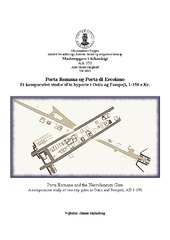Porta Romana og Porta di Ercolano Et komparativt studie af to byporte i Ostia og Pompeji, 1-150 e.Kr.
Master thesis
Permanent lenke
https://hdl.handle.net/1956/20550Utgivelsesdato
2019-07-04Metadata
Vis full innførselSamlinger
- Master theses [240]
Sammendrag
I denne masteropgave følges udviklingen ved byportene Porta di Ercolano i Pompeji, og Porta Romana i Ostia, i perioden 1 til 150 e.Kr. Det er særligt sammenspillet mellem byportene og de tilstødende områder, der er i fokus, såvel som områdernes brug, og hvorledes denne ændres over tid. Porta di Ercolanos udvikling slutter abrupt ved Vesuvs udbrud, den 24. august i år 79.e.K. Det er dermed ikke muligt at følge begge byporte igennem hele undersøgelsens tidsramme. Til gengæld har det været muligt at følge den videre udvikling ved Porta Romana, som lader til at være i en blomstrende udvikling i den følgende periode. Denne opgaves undersøgelser har tilvejebragt en udvidet forståelse af skiftet i brugen af byportene og deres tilstødende områder, og i særdeleshed hvorledes en sådan ændring synes at ske på vidt forskellige tidspunkter, ved hver især Porta di Ercolano og Porta Romana. This master thesis began as an investigation of two city gates, the Herculaneum Gate in Pompeii and the Porta Romana in Ostia, in combination with the exterior areas adjacent to them. The precise goal was to shed light upon the activities and exploits of the inhabitants during the period stretching from 1 A.D. to 150 A.D. This period was investigated specifically in order to follow the progress of building developments and changes in activities in both areas. Even though Pompeii ceased to exist following the volcanic eruption of Vesuvius on the 24th of August, 79 A.D., Ostia was still a thriving city. The survival of Ostia enabled a study of the further development of a necropolis, while at the same time facilitated hypotheses about the potential evolution of the necropolis of the Herculaneum Gate had it not been destroyed in 79 A.D. Contrary to this original prospect, a comparison between the two city gates and their necropoles revealed a correlation between the redesign of the Porta Romana city gate and a change in the building activity of the area. This change was already in effect in Pompei almost a century prior to when it began at Ostia. The results of this study show that the changes in the necropolis at the Herculaneum Gate evolved earlier on and had a wider range of buildings. This shows the existence of a multitude of activities compared to its counterpart at the Porta Romana, up until the annihilating volcanic eruption. Overall, there was a tendency towards a growing urbanization of both areas. Both necropoles go through an overwhelming change in the way they were used, from being a solely sacred place to becoming a somewhat urbanized area fully equipped with commercial and industrial buildings.
